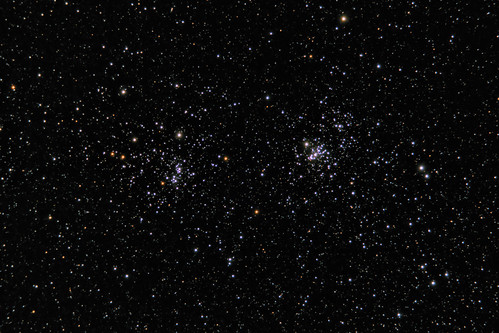15 March 2021, 19:45 – 22:30
Seeing: Average / Poor
Transparency: Average (cloud permitting)
A cool evening (after a mild day) with bands of high, hazy cloud drifting across the sky. Very light condensation on the telescope tube. The gentle breeze was a welcome change after a run of very blustery weather over the last few days.
With the nights getting shorter and a new lunar cycle already underway, this was probably my last opportunity for a while to explore the winter Milky Way, so I started at low power (50x) with the 24mm Panoptic, plus the OIII filter to pick out some nebulae. When using this filter you have to cup your hands around the eyepiece to get the best out of it, as it does tend to reflect stray light bouncing off your eyeball. (I’ve noticed this before, but tonight it was more prominent than usual, particularly on the right hand side of the field of view.)
NGC 2359, “Thor’s Helmet”, emission nebula, Canis Major
50x + OIII filter. The nebula showed up clearly with this eyepiece/filter combination, but only the brightest sections were visible tonight. Averted vision showed a bright spot on the northern part of the nebula.
The area northwest of NGC 2359 is rich in nebulae according to every chart I’ve seen, but nothing obvious jumped out at me when I scanned this region. Pushing on into Monoceros, I arrived at…
NGC 2237-9, Rosette Nebula, Monoceros
The area northwest of NGC 2359 is rich in nebulae according to every chart I’ve seen, but nothing obvious jumped out at me when I scanned this region. Pushing on into Monoceros, I arrived at…
NGC 2237-9, Rosette Nebula, Monoceros
50x + OIII filter. Visible as a very large, structureless haze surrounding open cluster NGC 2244. The nebula appeared widest and brightest on the north and west sides.
After sweeping north, to the Christmas Tree cluster, and then west, I stumbled upon something I hadn’t seen before:
NGC 2245, reflection nebula, Monoceros
After sweeping north, to the Christmas Tree cluster, and then west, I stumbled upon something I hadn’t seen before:
NGC 2245, reflection nebula, Monoceros
50x + OIII filter. Although catalogued as a reflection nebula (I didn’t know this at the time, as the chart doesn’t make a distinction between reflection and emission nebulae), it showed up very clearly as a small, fuzzy patch of light immediately southwest of a bright 8th magnitude star. Averted vision showed it to have a bright core. Increasing the magnification to 171x (no filter) improved the view considerably: now I could see an 11th magnitude star embedded in a wide, comet-shaped swathe of nebulosity fanning out to the southwest. Reminiscent of nearby NGC 2261 (Hubble’s Variable Nebula) but with a curved rather than a pointy apex. There was a hint of similar (albeit fainter) nebulosity corresponding with the position of nearby NGC 2247, but some hazy cloud pushed in before I could confirm it.
Relocating to a cloud-free (for now) part of the sky:
M97, Owl Nebula, Ursa Major
Relocating to a cloud-free (for now) part of the sky:
M97, Owl Nebula, Ursa Major
50x + OIII filter. Viewed at low power with an OIII filter, the Owl Nebula actually looked “bright” for once, appearing as a round, soft-edged disc of light. At 171x (no filter), it was faint, but the dark “eyes” were just about visible.
NGC 3893, galaxy, Ursa Major
NGC 3893, galaxy, Ursa Major
171x. Follow-up from the previous session. At this magnification the companion galaxy (NGC 3896) was visible with averted vision as a small, faint patch of light roughly east of the main galaxy, and adjacent to a 13th magnitude field star. Together, the two galaxies resembled a subdued version of the Whirlpool Galaxy (M51) and its neighbour as seen through a small telescope. Magnification makes the difference on this one; NGC 3896 was much harder to distinguish from the 13th magnitude star when I dropped down to 92x.
NGC 3166 and 3169, interacting galaxies, Sextans
NGC 3166 and 3169, interacting galaxies, Sextans
92x. Pair of small oval galaxies in same field of view, separated by a few arcminutes. Similar in size, but the western galaxy (NGC 3166) has a much brighter core. The other galaxy (NGC 3169) is just west of an 11th magnitude field star.
With more clouds pushing across the sky from the west, I called it a night.
With more clouds pushing across the sky from the west, I called it a night.









